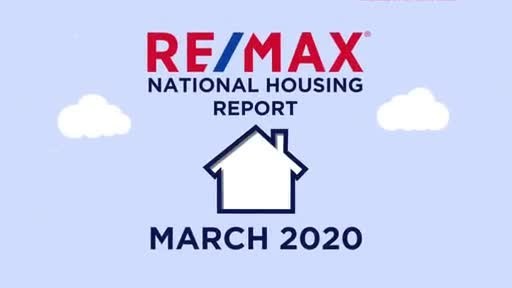DENVER, April 20, 2020 /PRNewswire/ -- Despite the advance of the coronavirus across the U.S. in the second half of the month, March home sales increased 2.7% year-over-year in the report's 52 markets – a hint of what might have been.
March was the fourth consecutive month with year-over-year increases in U.S. home sales – a streak not seen since 2016. But the spread of COVID-19, and the initiation of governmental measures to slow it, dampened the month's overall sales results:
- March's year-over-year sales growth of less than 3% was significantly less than December 2019 through February 2020 where year-over-year sales increases averaged 10%.
- The sequential monthly growth in sales from February to March is typically the largest month-over-month percentage increase each year, averaging 32%. This year, March sales increased just 23.8% over February – the lowest such increase for this time period in the report's nearly 12-year history.
Inventory levels in March continued to constrict amid healthy buyer interest, which helped drive further price increases. Year-over-year, March inventory declined 14.9%, continuing a streak that began in July 2019. Meanwhile, the Median Sales Price of $265,000 was 7.7% higher than a year ago, setting a report record for the month of March. A record low for March was the 54 Days on Market, while 2.7 Months Supply of Inventory was typical for the month, based on the past four years.
"As expected, the strong market of January and February continued into March, setting up a very good first quarter. But then the coronavirus and the initial mitigation measures arrived, disrupting our industry along with everything else," said Adam Contos, RE/MAX Holdings, Inc. CEO. "Conditions and restrictions vary throughout the country, so some areas continue to see new listings, pendings and closings, while other markets have slowed dramatically – especially where real estate was not deemed an essential service. It's a fluid situation. We believe that interest in buying or selling remains high, and pent up-demand in many places should drive sales higher over time."
Added Contos, "One takeaway that's already clear is that real estate agents, using technology and adhering to social distancing guidelines, can lead consumers through the buying or selling process in a largely virtual way. In many respects, the expertise of a skilled agent has never been more important."
Closed Transactions
Of the 52 metro areas surveyed in March 2020, the overall average number of home sales was up 23.8% compared to February 2020, and up 2.7% compared to March 2019. Leading the year-over-year sales percentage increase were Los Angeles, CA at +15.6%, Boise, ID at +15.2%, and Las Vegas, NV at +12.2%.
Median Sales Price – Median of 52 metro median prices
In March 2020, the median of all 52 metro Median Sales Prices was $265,000, up 2.9% from February 2020 and up 7.7% from March 2019. Only one metro area, Billings, MT at -0.4%, saw a year-over-year decrease in Median Sales Price. Seventeen metro areas increased year-over-year by double-digit percentages, with the largest increases seen in Birmingham, AL at +19.8%, Cincinnati, OH at +14.3%, and Salt Lake City, UT at +14.1%.
Days on Market – Average of 52 metro areas
The average Days on Market for homes sold in March 2020 was 54, down five days from the average in February 2020, and down five days from the average in March 2019. The metro areas with the lowest Days on Market were San Francisco, CA at 25, and a two-way tie between Seattle, WA and Omaha, NE at 30. The highest Days on Market averages were in Augusta, ME at 128, Des Moines, IA at 112, and Hartford, CT at 94. Days on Market is the number of days between when a home is first listed in an MLS and a sales contract is signed.
Months Supply of Inventory – Average of 52 metro areas
The number of homes for sale in March 2020 was up 1.1% from February 2020 and down 14.9% from March 2019. Based on the rate of home sales in March 2020, the Months Supply of Inventory decreased to 2.7 compared to 3.0 in February 2020, and decreased compared to 3.2 in March 2019. A six months supply indicates a market balanced equally between buyers and sellers. In March 2020, of the 52 metro areas surveyed, two metro areas reported a months supply at or over six, which is typically considered a buyer's market. The markets with the lowest Months Supply of Inventory were Manchester, NH at 1.2, and a six-way tie among Boise, ID, Washington DC, Denver, CO, Seattle, WA, Omaha, NE, and San Francisco, CA at 1.3.
For specific data in this report or to request an interview, please contact [email protected]
About the RE/MAX Network
As one of the leading global real estate franchisors, RE/MAX, LLC is a subsidiary of RE/MAX Holdings (NYSE: RMAX) with over 130,000 agents in more than 110 countries and territories. Nobody in the world sells more real estate than RE/MAX, as measured by residential transaction sides. Dedicated to innovation and change in the real estate industry, RE/MAX launched Motto Mortgage, a ground-breaking mortgage franchisor, in 2016 and acquired booj, a real estate technology company, in 2018. RE/MAX agents have lived, worked and served in their local communities for decades, raising millions of dollars every year for Children's Miracle Network Hospitals® and other charities. To learn more about RE/MAX, to search home listings or find an agent in your community, please visit www.remax.com. For the latest news about RE/MAX, please visit news.remax.com.
Description
The RE/MAX National Housing Report is distributed each month on or about the 15th. The first Report was distributed in August 2008. The Report is based on MLS data in approximately 52 metropolitan areas, includes all residential property types, and is not annualized. For maximum representation, many of the largest metro areas in the country are represented, and an attempt is made to include at least one metro from each state. Metro area definitions include the specific counties established by the U.S. Government's Office of Management and Budget, with some exceptions.
Definitions
Transactions are the total number of closed residential transactions during the given month. Months Supply of Inventory is the total number of residential properties listed for sale at the end of the month (current inventory) divided by the number of sales contracts signed (pended) during the month. Where "pended" data is unavailable, this calculation is made using closed transactions. Days on Market is the number of days that pass from the time a property is listed until the property goes under contract for all residential properties sold during the month. Median Sales Price is the median of the median sales prices in each of the metro areas included in the survey.
MLS data is provided by contracted data aggregators, RE/MAX brokerages and regional offices. While MLS data is believed to be accurate, it cannot be guaranteed. MLS data is constantly being updated, making any analysis a snapshot at a particular time. Every month the RE/MAX National Housing Report re-calculates the previous period's data to ensure accuracy over time. All raw data remains the intellectual property of each local MLS organization.
SOURCE RE/MAX, LLC

Related Links
WANT YOUR COMPANY'S NEWS FEATURED ON PRNEWSWIRE.COM?
Newsrooms &
Influencers
Digital Media
Outlets
Journalists
Opted In






Share this article